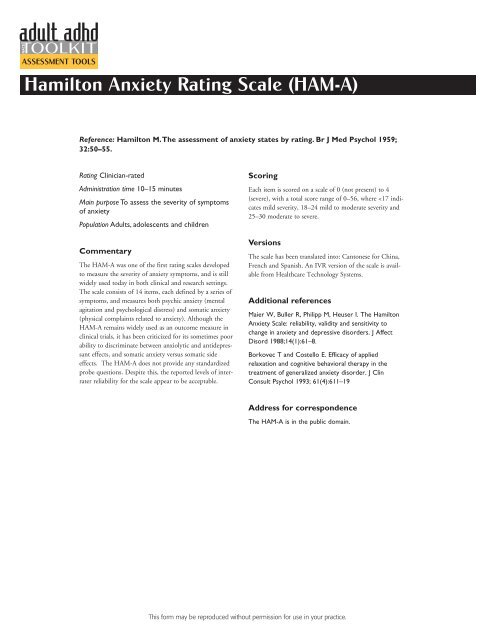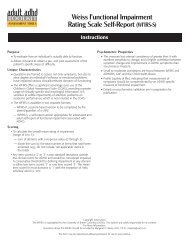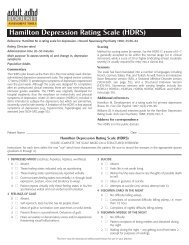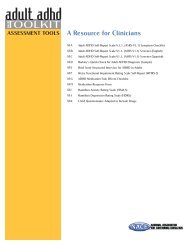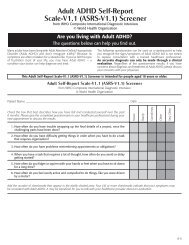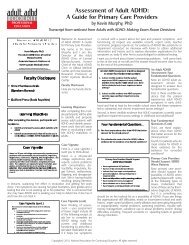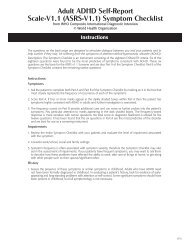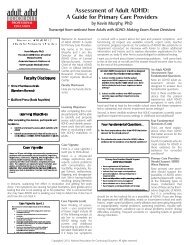Hamilton Anxiety Rating Scale (HAM-A) - naceonline.com
Hamilton Anxiety Rating Scale (HAM-A) - naceonline.com
Hamilton Anxiety Rating Scale (HAM-A) - naceonline.com
Create successful ePaper yourself
Turn your PDF publications into a flip-book with our unique Google optimized e-Paper software.
ASSESSMENT TOOLS<strong>Hamilton</strong> <strong>Anxiety</strong> <strong>Rating</strong> <strong>Scale</strong> (<strong>HAM</strong>-A)Reference: <strong>Hamilton</strong> M.The assessment of anxiety states by rating. Br J Med Psychol 1959;32:50–55.<strong>Rating</strong> Clinician-ratedAdministration time 10–15 minutesMain purpose To assess the severity of symptomsof anxietyPopulation Adults, adolescents and childrenCommentaryThe <strong>HAM</strong>-A was one of the first rating scales developedto measure the severity of anxiety symptoms, and is stillwidely used today in both clinical and research settings.The scale consists of 14 items, each defined by a series ofsymptoms, and measures both psychic anxiety (mentalagitation and psychological distress) and somatic anxiety(physical <strong>com</strong>plaints related to anxiety). Although the<strong>HAM</strong>-A remains widely used as an out<strong>com</strong>e measure inclinical trials, it has been criticized for its sometimes poorability to discriminate between anxiolytic and antidepressanteffects, and somatic anxiety versus somatic sideeffects. The <strong>HAM</strong>-A does not provide any standardizedprobe questions. Despite this, the reported levels of interraterreliability for the scale appear to be acceptable.ScoringEach item is scored on a scale of 0 (not present) to 4(severe), with a total score range of 0–56, where
Patient Name ___________________________________________________________________ Date ___________________________<strong>Hamilton</strong> <strong>Anxiety</strong> <strong>Rating</strong> <strong>Scale</strong> (<strong>HAM</strong>-A)Below is a list of phrases that describe certain feeling that people have. Rate the patients by finding the answer which best describes the extentto which he/she has these conditions. Select one of the five responses for each of the fourteen questions.0 = Not present, 1 = Mild, 2 = Moderate, 3 = Severe, 4 = Very severe. 1 Anxious mood 0 1 2 3 4Worries, anticipation of the worst, fearful anticipation, irritability. 2 Tension 0 1 2 3 4Feelings of tension, fatigability, startle response, moved to tearseasily, trembling, feelings of restlessness, inability to relax. 3 Fears 0 1 2 3 4Of dark, of strangers, of being left alone, of animals, of traffic, ofcrowds. 4 Insomnia 0 1 2 3 4Difficulty in falling asleep, broken sleep, unsatisfying sleep and fatigueon waking, dreams, nightmares, night terrors. 5 Intellectual 0 1 2 3 4Difficulty in concentration, poor memory. 6 Depressed mood 0 1 2 3 4Loss of interest, lack of pleasure in hobbies, depression, early waking,diurnal swing. 7 Somatic (muscular) 0 1 2 3 4Pains and aches, twitching, stiffness, myoclonic jerks, grinding ofteeth, unsteady voice, increased muscular tone. 8 Somatic (sensory) 0 1 2 3 4Tinnitus, blurring of vision, hot and cold flushes, feelings of weakness,pricking sensation. 9 Cardiovascular symptoms 0 1 2 3 4Tachycardia, palpitations, pain in chest, throbbing of vessels, faintingfeelings, missing beat. 10 Respiratory symptoms 0 1 2 3 4Pressure or constriction in chest, choking feelings, sighing, dyspnea. 11 Gastrointestinal symptoms 0 1 2 3 4Difficulty in swallowing, wind abdominal pain, burning sensations,abdominal fullness, nausea, vomiting, borborygmi, looseness ofbowels, loss of weight, constipation. 12 Genitourinary symptoms 0 1 2 3 4Frequency of micturition, urgency of micturition, amenorrhea,menorrhagia, development of frigidity, premature ejaculation, loss oflibido, impotence. 13 Autonomic symptoms 0 1 2 3 4Dry mouth, flushing, pallor, tendency to sweat, giddiness, tensionheadache, raising of hair. 14 Behavior at interview 0 1 2 3 4Fidgeting, restlessness or pacing, tremor of hands, furrowed brow,strained face, sighing or rapid respiration, facial pallor, swallowing,etc.


